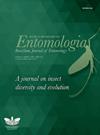Living in the sunlight: micro-environments with higher exposure of sunlight have more abundance and diversity of Hymenoptera in a Brazilian Atlantic Forest fragment
IF 1.3
4区 农林科学
Q4 ENTOMOLOGY
引用次数: 0
Abstract
Tropical forests are three-dimensional with the presence of numerous micro-environments formed by horizontal and vertical gradients. Such micro-environments can affect the nesting preference of organisms, including the trap-nesting Hymenoptera. Bees and wasps are key elements in ecosystems and are considered as sensitive to environmental changes, and trap-nests sampling methodology is widely used in their ecological and conservation studies. However, many uncertainties remain about nesting site preferences. From this perspective, our aim is to assess the diversity descriptors of trap-nesting Hymenoptera in different micro-environments. The sampling was conducted on three micro-environments (canopy, understory and treefall gaps) replicated on ten permanent plots within a Brazilian Atlantic forest hotspot. In each micro-environment, we installed trap-nest stations made by a set of twenty bamboo artificial nests. We found 762 brood cells from ten wasp and five bee species. The rarefaction curves indicate the lower species richness in understory stations, while treefall gaps and canopy stations were not significantly different. We analyzed abundance, mortality and parasitism rates using generalized linear models, but only abundance varies significantly among micro-environments. Our data indicates that trap-nesting Hymenoptera prefer to nest in micro-environments with higher exposure of sunlight. Canopy and treefall gap assemblages are consistently more abundant and diverse than understory probably due the higher temperature and lower humidity. On the other hand, mortality, parasitism rates, and the species composition were similar among environments. Our hypothesis is that the species composition was not affected as these species have a foraging range that encompasses nearby micro-environments.生活在阳光下:巴西大西洋森林片段中,高日照的微环境具有更高的膜翅目昆虫丰度和多样性
热带森林是三维的,存在许多由水平和垂直梯度形成的微环境。这种微环境可以影响生物的筑巢偏好,包括陷阱筑巢膜翅目昆虫。蜜蜂和黄蜂是生态系统的重要组成部分,对环境变化非常敏感,巢夹取样法被广泛应用于它们的生态和保护研究。然而,筑巢地点的偏好仍然存在许多不确定性。从这个角度出发,我们的目的是评估不同微环境下陷阱筑巢膜翅目昆虫的多样性描述。在巴西大西洋森林热点地区的10个永久样地上复制了三种微环境(冠层、林下和树落间隙)。在每个微环境中,我们安装了由20个竹人工鸟巢组成的陷阱巢站。我们从10种黄蜂和5种蜜蜂中发现了762个育雏细胞。稀疏曲线表明林下站位的物种丰富度较低,林隙和冠层站位的物种丰富度差异不显著。我们使用广义线性模型分析了丰度、死亡率和寄生率,但只有丰度在微环境中存在显著差异。我们的数据表明,膜翅目昆虫更喜欢在阳光照射较多的微环境中筑巢。冠层和林隙组合始终比林下更丰富和多样化,这可能是由于较高的温度和较低的湿度。另一方面,不同环境下蝇类的死亡率、寄生率和种类组成相似。我们的假设是,物种组成没有受到影响,因为这些物种有一个包括附近微环境的觅食范围。
本文章由计算机程序翻译,如有差异,请以英文原文为准。
求助全文
约1分钟内获得全文
求助全文
来源期刊
CiteScore
1.50
自引率
12.50%
发文量
14
审稿时长
6-12 weeks
期刊介绍:
Information not localized

 求助内容:
求助内容: 应助结果提醒方式:
应助结果提醒方式:


